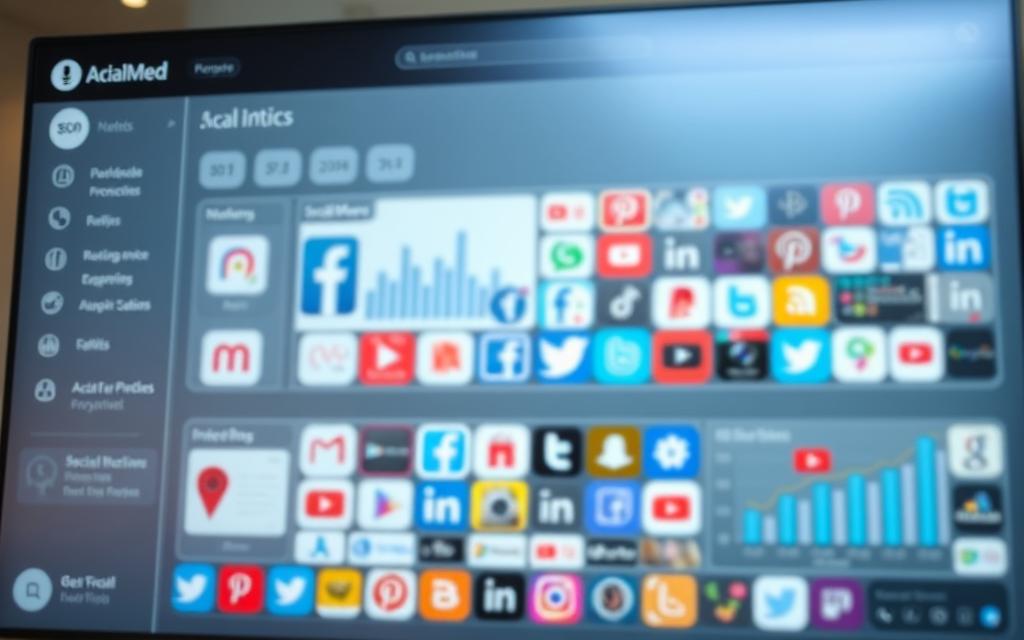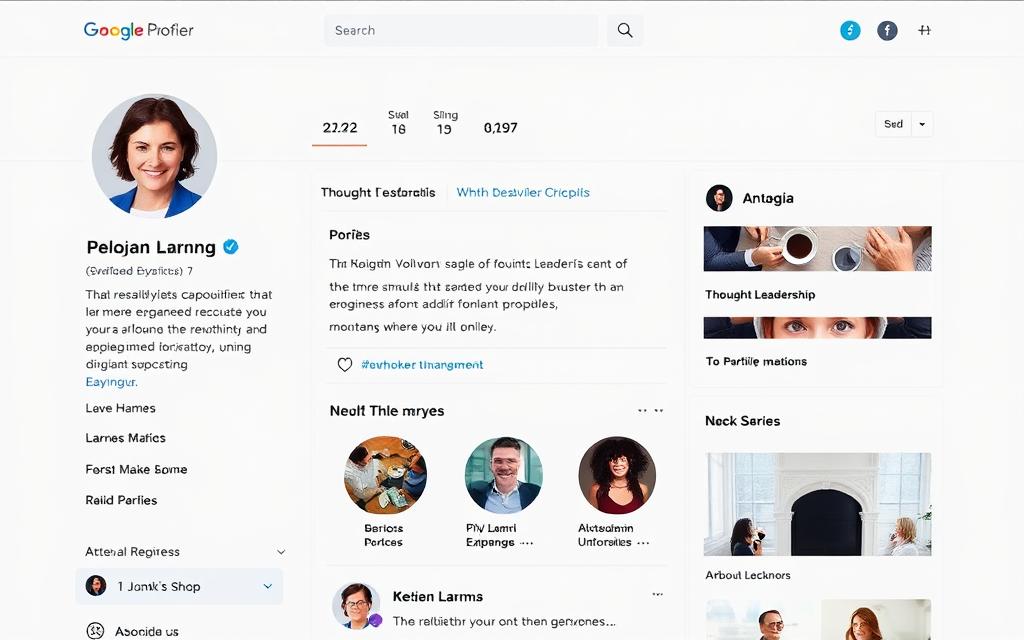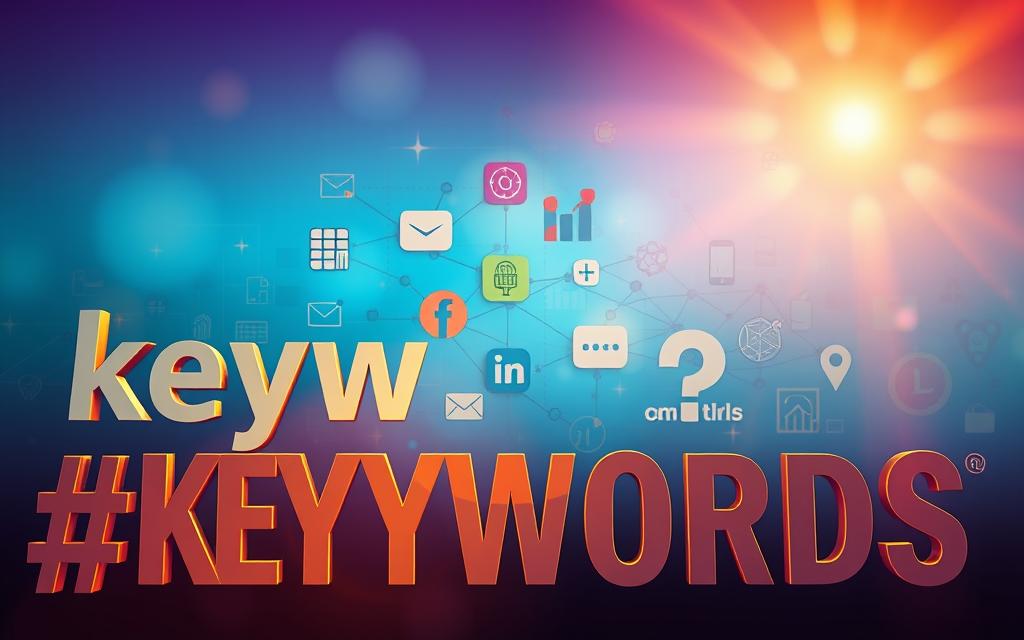Building online visibility requires blending two powerful strategies: fostering connections and optimizing content. While one focuses on building relationships, the other uses data-driven keyword analysis to boost search performance. Together, they create a dynamic approach for modern marketers.
Platforms like Instagram or YouTube aren’t just for engagement—they influence how search engines view your brand. For example, Adobe found that content shared widely on networks often gains traction in organic search results. This overlap shows why treating these tactics separately limits potential.
This guide breaks down how aligning organic search efforts with platform-specific tactics drives measurable results. You’ll learn to leverage trending topics, refine metadata, and track metrics that matter. Let’s explore how blending these methods unlocks sustainable growth in today’s competitive digital space.
Introduction to Social Media and SEO
Effective online presence hinges on two interconnected pillars: engagement and discoverability. One builds relationships through conversations, while the other ensures your brand appears where audiences actively search. Let’s unpack how these strategies work together.
Defining the Concepts and Scope
Social media marketing centers on fostering connections via platforms like Facebook or TikTok. Profiles act as digital storefronts—consistent names, bios, and links help search engines recognize your brand. Posts that spark discussions or shares amplify visibility, creating ripples beyond the platform itself.

Why Integration Matters for Modern Marketing
Imagine a viral Instagram Reel driving users to your website. Each click signals relevance to search engines, potentially lifting rankings. For instance, a bakery updating its profile with location-based keywords saw a 40% traffic boost from local searches. Shared content also earns backlinks—a core SEO factor—when others reference your posts.
Blending these efforts isn’t optional. Platforms shape how algorithms perceive your authority. Clear profiles and strategic posts create a feedback loop: engagement fuels discoverability, which sparks more engagement. It’s how modern brands stay visible in a crowded digital space.
Social Media and SEO: Foundational Concepts
The digital landscape thrives on interconnected strategies where visibility and interaction fuel growth. While search engines prioritize relevance, user behavior on media platforms often acts as a compass for ranking decisions. This synergy creates opportunities to amplify reach through shared goals.

How Engagement Shapes Discoverability
High-performing posts on platforms like TikTok or LinkedIn don’t just entertain—they signal authority to algorithms. A Moz study found pages with strong social shares rank 22% higher in search results. Why? Search engines interpret shares as endorsements, boosting credibility for related queries.
Consider this: when users engage with your content—liking, commenting, or saving—they create behavioral data. These signals help algorithms assess content quality. For example, brands using media SEO techniques in video descriptions see 35% more organic traffic, according to recent analyses.
Key takeaways:
- Platform activity indirectly influences rankings through backlinks and brand searches.
- Consistent messaging across channels builds trust with both audiences and crawlers.
- Content optimized for shareability often performs better in localized searches.
One retail brand saw a 50% traffic surge after aligning trending hashtags with product page keywords. This blend of engagement and technical optimization creates a virtuous cycle—each reinforcing the other’s impact.
Mastering Social Media and SEO Strategies
Combining creativity with technical precision unlocks new opportunities for digital growth. When platforms and search strategies align, brands amplify their reach while building lasting connections. Let’s explore how this partnership drives measurable results.

Why Blending Platforms and Search Matters
Adobe’s approach demonstrates the power of synergy. By sharing data-driven reports across networks, they saw a 27% increase in branded search queries. Their media profiles included keywords mirroring blog topics, creating a cohesive narrative that search engines rewarded.
Ahrefs takes it further by linking trending posts to in-depth guides. One campaign drove 15% more organic traffic by aligning hashtags with long-tail keywords. This strategy not only boosts brand visibility but also encourages backlinks—like when industry sites reference shared studies.
Creating a Cohesive Digital Ecosystem
Well-crafted media posts act as gateways to deeper content. For example:
- Posts with video summaries of blog articles earn 3x more shares.
- Profiles optimized with location terms attract 40% more local traffic.
- Campaigns using platform analytics to refine website metadata see faster indexing.
These tactics build authority while fostering trust. Users who discover your brand through search are more likely to engage with your platform content, creating a loop of visibility and credibility. Meanwhile, authoritative content shared strategically strengthens both search rankings and community relationships.
Optimizing Social Media Profiles for SEO
Your digital profiles act as silent ambassadors, bridging discovery and engagement. When crafted thoughtfully, they become powerful tools to attract your target audience while signaling relevance to search algorithms. Let’s explore how small tweaks create big visibility wins.

Profile Optimization Best Practices
Platform profiles rank in search results, functioning as secondary landing pages. A clear profile picture and updated cover photo establish credibility. Verified accounts, like those on Twitter or Pinterest, gain algorithmic trust—a fitness brand saw 30% more clicks after verification.
Bios should weave keywords naturally. For example, a coffee shop using “organic espresso” and “downtown café” attracts local searches. Avoid stuffing phrases; focus on clarity. Include a call-to-action link directing users to your latest blog post or product page—this ties content social efforts to measurable actions.
Key steps to align with your SEO strategy:
- Use location tags and industry terms in descriptions
- Update links quarterly to reflect current campaigns
- Analyze profile traffic to refine keyword choices
These optimizations help platforms like Google understand your niche. One skincare brand boosted organic visits by 25% after matching their bio keywords to trending search queries. Regular audits ensure your profiles stay sharp and relevant.
Crafting SEO-Friendly Social Content
Great content blends creativity with search-friendly tweaks. Optimizing posts and media elements helps platforms and search engines recognize your value. This dual focus turns casual scrollers into loyal visitors while boosting discoverability.
Smart Keyword Integration
Work relevant terms naturally into captions and bios. A travel brand might use “adventure gear” in Instagram posts while including “outdoor equipment” in their bio. Tools like AnswerThePublic reveal phrases audiences actually search for.
Hashtags double as keywords when chosen strategically. #EcoFriendlyFashion performs better than generic tags like #Style. Track engagement to refine choices over time.
ALT Text and Metadata Mastery
Descriptive ALT text makes images accessible while feeding search algorithms. A bakery sharing cupcake photos could use “gluten-free vanilla cupcakes with sprinkles” instead of “dessert.jpg”. This simple change helped one cafe drive traffic from image searches.
For videos, include keywords in titles and descriptions. A tech company explaining “data encryption” saw 20% more views after updating metadata. Presentations shared on SlideShare gain traction when filenames contain target phrases.
These tactics create ripple effects. A fitness influencer gained 1,200 newsletter signups by pairing keyword-rich captions with ALT-text-optimized workout demos. Better visibility meets user needs—a win for rankings and human visitors alike.
Leveraging Social Media Platforms for Increased Engagement
Ever wondered why some brands dominate certain platforms while others struggle? Tailoring your approach to each channel’s unique culture and features is key. A fitness apparel company, for instance, boosted website visits by 65% after customizing posts for Facebook, Instagram, and TikTok—proving one-size-fits-all doesn’t work.

Platform-Specific Techniques That Convert
Facebook thrives on community-building. Brands using niche groups see 3x longer session times, as members actively discuss topics. One outdoor gear retailer linked group discussions to blog posts, driving a 40% traffic spike.
Instagram’s algorithm favors visually cohesive feeds and pinned posts. A beauty brand increased engagement by 55% after pinning tutorials with keyword-rich captions. TikTok demands authenticity—short videos using trending sounds or challenges perform best. A bakery’s viral “Cake Art Challenge” reel brought 1,200 new followers in a week.
Hootsuite reports campaigns aligned with platform strengths achieve 70% higher conversion rates. For example:
- Instagram Stories with polls or quizzes boost direct website clicks
- Facebook Live sessions generate 6x more comments than pre-recorded videos
- TikTok’s “For You” page prioritizes content with high watch-through rates
Consistent branding—like matching color schemes and voice—builds recognition. Join discussions on internet marketing strategies to refine your cross-platform approach. When content resonates culturally and technically, it bridges casual viewers into loyal customers.
Integrating Keywords and Hashtags Effectively
Smart keyword and hashtag strategies transform casual viewers into engaged audiences. By aligning search intent with platform trends, brands amplify discoverability while maintaining authenticity.

How to Perform Effective Keyword Research
Start with tools like AnswerThePublic or Ubersuggest to identify long-tail phrases. A travel agency increased website clicks by 33% after targeting “best carry-on luggage for Europe” instead of generic terms. Analyze competitors’ top-performing posts using SEMrush—look for gaps in their keyword coverage.
Follow this 3-step process:
- Map audience pain points to search queries (e.g., “how to style curly hair” for beauty brands)
- Group terms by engagement potential and search volume
- Test variations in captions using A/B testing tools
One SaaS company boosted conversions by 18% after following a step-by-step keyword research process tailored for LinkedIn content.
Best Practices for Hashtag Utilization
Mix trending and niche tags to balance reach and relevance. A bakery using #VeganTreats alongside #LocalDesserts saw a 27% follower increase. Limit hashtags to 5-8 per post—Instagram reports 30% higher interaction rates with this approach.
Platform-specific tips:
- Twitter: Use 1-2 concise tags in threads
- Pinterest: Include keywords directly in pin descriptions
- TikTok: Leverage challenge-specific hashtags for algorithm favor
Tools like RiteTag help identify high-performing tags. A fashion retailer’s #SustainableDenim campaign drove 42% more profile visits by pairing optimized hashtags with strategic content alignment.
Building Quality Links and Driving Organic Traffic
Links act as digital bridges, connecting your brand to broader audiences while signaling authority to search algorithms. While traditional backlinks remain vital, creative approaches through profiles and collaborations offer fresh pathways to boost visibility.
Smart Tactics for Profile-Driven Connections
Platform profiles serve as launchpads for link-building. Adobe’s strategy of sharing research reports on LinkedIn generated 120+ backlinks from industry sites. Their team embedded profile URLs in guest posts, creating a referral loop that increased organic visits by 18%.
Even no-follow links drive value. Ahrefs found that 35% of their website traffic comes from platforms like Twitter—links that don’t pass ranking power but attract engaged visitors. A tech startup saw 500+ monthly visits by adding their blog URL to Pinterest pins and YouTube descriptions.
Practical methods to try:
- Partner with influencers to co-create content featuring your product links
- Embed share buttons on blog posts to encourage platform redistribution
- Reference older articles in new posts with phrases like “As we discussed in [topic]”
Quality engagement sparks natural link growth. A cooking channel gained 87 backlinks after viewers shared their tutorials on forums and recipe sites. By blending strategic collaborations with genuine audience interactions, brands build lasting visibility.
Influencer Collaborations and Community Engagement Tactics
Authentic connections fuel modern marketing success. Partnering with trusted voices and fostering active groups amplifies reach while building credibility. These efforts don’t just boost visibility—they create loyal advocates who drive meaningful results.
Establishing Relationships With Trusted Voices
Adobe’s micro-influencer campaign highlights the power of strategic partnerships. By collaborating with niche creators in design communities, they drove a 30% traffic increase to tutorial pages. These collaborations earned backlinks from industry blogs, signaling authority to search engines.
Steps to build effective partnerships:
- Identify influencers whose values align with your brand
- Co-create content that solves audience pain points
- Track metrics like referral traffic and engagement rates
One outdoor gear brand saw organic visits double after influencers shared hiking guides linking to their site. Regular check-ins and shared goals keep these relationships productive.
Nurturing Active Brand Communities
Platforms like Facebook Groups or LinkedIn Clubs turn followers into collaborators. A skincare company’s “Clean Beauty Collective” group generated 500+ user reviews monthly. These discussions often rank for long-tail keywords, pulling in new visitors from search results.
Proven tactics for engagement:
- Host weekly Q&A sessions to address common queries
- Encourage members to share experiences using branded hashtags
- Reward active participants with early access to products
Communities become content hubs. A fitness app’s Facebook group members created 80% of their top-performing blog topics. This user-generated content improved domain authority, leading to higher rankings for competitive terms.
Technical SEO Aspects in Social Media Sharing
Behind every viral post lies a technical foundation that keeps audiences engaged. While flashy visuals grab attention, load speeds and metadata determine whether visitors stay or bounce. Let’s explore how these behind-the-scenes tweaks maximize your content’s impact.
Understanding Follow vs. No-Follow Links
Platforms automatically add no-follow attributes to most shared links. These tell search engines not to pass ranking authority. But profile bios often allow follow links—golden opportunities to boost domain authority. For example, linking your website in an Instagram bio creates a valuable backlink.
Google’s 2023 study shows pages with follow links in bios rank 18% higher for branded searches. Regular posts still drive traffic, but bios offer lasting technical benefits. Always prioritize profile links for key landing pages.
Optimizing Shared Media and Load Times
Slow-loading content frustrates users and algorithms. Research by Portent reveals pages loading in 1 second have 5x higher engagement than those taking 5 seconds. Compress images to under 100KB using tools like TinyPNG—this reduced bounce rates by 53% for one fashion brand.
Three technical tweaks for better performance:
- Use WebP format for images to cut file sizes by 30%
- Host videos on platforms like YouTube, then embed them
- Test load speeds using Google’s PageSpeed Insights
These adjustments help platforms prioritize your content. A tech startup saw 40% longer watch times after optimizing their tutorial videos. Remember—technical polish turns casual clicks into meaningful connections.
Case Studies: Real-World Applications of Social Media SEO
What separates brands that climb search rankings from those stuck on page two? Real-world success stories reveal how blending platform tactics with technical optimization drives results. Let’s examine companies that transformed visibility through integrated strategies.
Adobe’s Blueprint for Cross-Channel Synergy
Adobe partnered with 150+ micro-influencers to promote their Creative Cloud tutorials. Each creator shared tips using branded hashtags linked to optimized landing pages. This campaign generated 12,000+ backlinks from industry blogs—boosting domain authority by 18%.
Their team also revamped profile bios with keywords like “design software solutions.” Within six months, branded searches increased 32%, while tutorial pages ranked for 1,200+ terms. The secret? Aligning creator content with engine preferences for video-rich results.
Ahrefs and the Power of Data-Driven Content
Ahrefs leveraged LinkedIn polls to identify trending SEO questions. They transformed insights into blog posts, then shared snippets with keyword-rich captions. One guide on “link-building tools” earned 8,500+ shares and climbed to #1 for its target phrase.
A fashion retailer replicated this approach using user-generated content. Encouraging users to tag outfits with location-based hashtags improved local search visibility by 45%. Their product pages now dominate “sustainable denim” queries in 12 cities.
Key lessons from these campaigns:
- Collaborative content builds authority faster than solo efforts
- Profile optimization directly impacts branded search performance
- Platform analytics reveal untapped keyword opportunities
Future Trends and Analytics in Social Media and SEO
Staying ahead in digital marketing means anticipating shifts before they trend. Platforms now prioritize authenticity over polished content, with algorithms rewarding genuine interactions. Meanwhile, search engines increasingly index dynamic posts, blurring lines between discovery channels.
Emerging Trends in Algorithms
Short-form videos dominate feed rankings—TikTok-style clips now drive 3x more engagement than static posts. Platforms like Instagram prioritize reels in Explore pages, creating new paths for visibility. Algorithm updates also favor:
- Content with high watch time and shares
- Posts using trending audio or AR filters
- Creators who post consistently (3-4x weekly)
Data-Driven Strategy Adjustments
Analytics tools like Google Analytics 4 and Brandwatch help decode performance patterns. Track keyword performance across platforms to identify rising queries. For example, brands using YouTube analytics to refine video titles saw 25% more search impressions.
Three actionable steps:
- Use heatmaps to optimize video thumbnails
- A/B test captions with different keyword placements
- Monitor real-time engagement spikes to boost trending posts
Industry forecasts predict deeper integration between search engines and platform content. Adapt by testing formats like shoppable videos and interactive polls. Agility paired with data turns trends into lasting visibility wins.
Conclusion
Digital success today hinges on blending audience engagement with search-friendly tactics. By aligning platform activity with technical optimizations, brands unlock lasting visibility. Profiles optimized for keywords, content tailored to trends, and data-driven adjustments form the core of this strategy.
Three steps to start now: audit profile bios for search terms, embed links in high-traffic posts, and track metrics like shares and click-through rates. Over time, these efforts compound—boosting organic traffic while strengthening domain authority. For example, pages optimized for speed and mobile users often climb rankings faster.
Stay agile. Test new formats like short videos or interactive polls. Analyze performance monthly to refine your approach. For deeper insights, explore proven SEO best practices that complement platform efforts. Continuous learning turns today’s experiments into tomorrow’s rankings.
